Abstract
Despite increasing attention to inclusive education, the spatial and environmental requirements of individuals with Down syndrome remain insufficiently addressed within architectural research. This study investigates how educational environments can be redesigned to betteraccommodate the developmental, sensory, and behavioral needs of this user group, utilizing the interdisciplinary lens of building biology that emphasizes occupant health, well-being, and environmental quality. Employing a case study methodology, this study focuses on Gülseren Özdemir Special Education Practice School in Turkey. Fieldwork was conducted through structured qualitative spatial analysis based on principles derived from building biology and universal design. While the facility meets several baseline accessibility criteria, qualitative observations indicate areas for improvement, particularly in lighting quality, acoustic conditions, tactile stimuli, and spatial adaptability. These findings demonstrate the potential of building biology to serve as a comprehensive, health-centered design approach for inclusive educational settings. This study concludes by proposing spatial strategies applicable to both new construction and retrofit projects, offering a knowledge base that may inform future architectural practices aimed at fostering inclusive and supportive learning environments.
1. Introduction
Although inclusive education has gained prominence, the spatial and environmental needs of individuals with Down syndrome are still largely overlooked in mainstream settings. This neglect restricts not only access but also cognitive and socio-emotional development [1,2]. Building biology, which emphasizes human health, environmental quality, and psychological well-being in architectural design [3], offers an important framework for addressing these overlooked needs through spatial interventions. Research indicates that the layout, ergonomics, and sensory conditions of educational facilities directly impact learning behaviors and social interactions [4,5]. Interior architecture, therefore, assumes a crucial developmental and social role, particularly for individuals with special needs [6]. This study presents building biology (Bau Biologie) as a comprehensive methodology that examines the influence of buildings on occupant health and environmental sustainability. Its primary aim is to promote the development of healthy, sustainable, and high-quality residential and occupational environments through the optimization of indoor climate conditions and the meticulous selection of materials, furniture, and furnishings [7]. Within this overarching framework, this article explicitly underscores interior features that most directly enhance perceptual clarity and cognitive–sensory accessibility, namely barrier-free circulation, color strategy, visual contrast, and graphical and tactile signage.
Recent research underscores the importance of integrating building biology principles, universal design approaches, and multisensory spatial strategies in the design of special education environments. Multisensory interior design has been shown to enhance environmental perception and learning for students with Down syndrome [8], while universal design principles contribute positively to learning outcomes for students with significant intellectual disabilities [9]. The spatial configuration of innovative learning environments has also been linked to a stronger sense of belonging and participation among students with disabilities [10]. In addition, environmental parameters such as lighting, acoustics, and ventilation have been found to directly affect student health and performance, reinforcing the relevance of building biology in educational settings [11]. Access to natural views further supports stress reduction and cognitive restoration [12]. Collectively, these findings highlight the need for a holistic design approach that incorporates environmental quality, biophilic principles, and inclusive design to better support the needs of diverse learners.
This study employs the principles of building biology (Bau-Biologie) to assess the spatial adequacy of Gülseren Özdemir Special Education Practice School and to propose evidence-based design criteria tailored to the specific needs of individuals with Down syndrome. Building biology is defined here as a holistic approach that investigates the relationship between the built environment, human health, and environmental sustainability. Its core objective is to promote healthy, sustainable, and high-quality living and working environments by optimizing indoor conditions and carefully selecting construction materials, interior elements, and furnishings [7]. Within this comprehensive framework, this study concentrates on interior design strategies that directly support perceptual clarity and cognitive–sensory accessibility, particularly barrier-free circulation, intentional color use, visual contrast, and the integration of both graphical and tactile signage systems. The school is a purpose-built facility commissioned by the Limak Foundation and opened in 2018. To bridge the gap between existing spatial design standards and the needs of students with special needs, this study addresses the following questions:
- (1)
- How well do the spatial features of the selected school align with building biology principles and universal design standards?
- (2)
- What specific design improvements can be recommended to boost accessibility and effectiveness for students with special needs?
- (3)
- How can these design principles be implemented more widely in similar educational environments?
Based on these questions, this study proposes the following hypothesis: Educational spaces that incorporate building biology principles and universal design standards will significantly enhance accessibility, safety, and user experience for students with special needs.
1.1. Disability as a Concept: A Terminological and Theoretical Reappraisal
The United Nations’ “Declaration on the Rights of Disabled Persons” defines disability as the inability, due to physical or mental impairments, to fully perform age- and gender-expected social roles [13]. However, contemporary scholarship critiques this definition, arguing for a shift beyond normative societal views. Historical terms like “invalid” or “handicapped” highlight the need for more inclusive language grounded in human rights and social inclusion.
The challenge is not just changing words but transforming societal attitudes, as new terms risk acquiring similar negative connotations without cultural change. Modern disability theories view disability as socially constructed through physical, social, and psychological barriers rather than solely biological differences. This study aims to support this inclusive perspective by using “individual with special needs” instead of “disabled person”, emphasizing environmental support for realizing individual potential rather than marginalization.
1.2. Down Syndrome: Theoretical and Conceptual Perspectives
Down syndrome is a genetic chromosomal condition caused by an extra copy of chromosome 21 (trisomy 21), affecting cognitive, physical, and developmental traits [14]. It should be understood not merely as a biological anomaly but as a multidimensional condition influenced by social and environmental factors. Üstündağ [15] describes it as part of humanity’s biological diversity.
Typical physical features include a flat facial profile, short neck, hypotonia, joint hyperflexibility, and distinct hand characteristics [16,17,18]. Individuals with Down syndrome often face cognitive challenges but also exhibit strong social skills, communicative openness, and an affinity for music, supporting social adaptation.
1.3. Building Biology: Principles and Theoretical Groundings
A spatial environment, as illustrated in Figure 1, must address users’ physical and psychological needs by functioning as a “third skin” that mediates their interaction with the built world [20]. Building biology offers a human-centered and ecologically informed approach to minimizing environmental risks in architectural design.
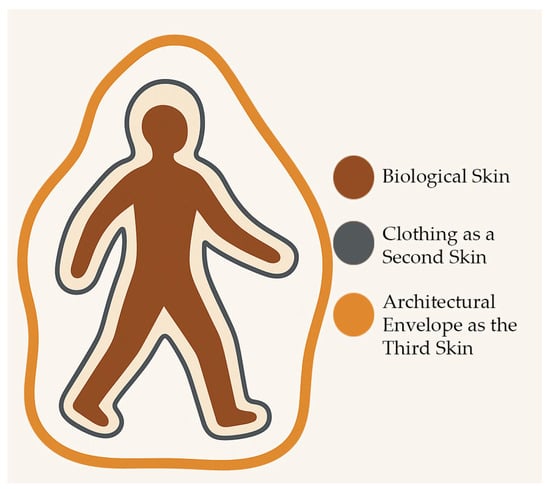
Figure 1.
The theoretical framework of the “third skin” concept.
A well-designed spatial environment must address both the physiological and psychological needs of its users, serving as a protective and adaptive layer that mediates their interaction with the built world [20]. In this context, building biology emerges as an interdisciplinary framework that prioritizes human health, environmental quality, and ecological balance by reducing the adverse effects of architectural and material systems.
Designers must consider users’ psychological and social needs because unmet needs can harm mental and physical health, potentially causing illness [21,22]. Beyond aesthetics, spatial design should address emotional well-being [23]. Psychological comfort involves safety, functionality, aesthetics, tranquility, and social interaction. Users feel healthier and happier when they can control and personalize their environment, which is influenced by interior dimensions, furniture placement, and spatial organization [24].
Light affects health through vision, vitamin D synthesis, and regulating circadian rhythms and hormones (cortisol, serotonin, melatonin), which influence mood and stress [25]. Colors also profoundly impact behavior and productivity; cool tones calm, while warm tones stimulate [24,26]. Historically, color therapy was used in many cultures for its physical and psychological effects.
Healthy indoor air quality depends on temperature, humidity, ventilation, and fresh air. Poor air quality harms physical and cognitive function, causing respiratory issues, headaches, fatigue, and cognitive impairments [25].
Acoustic comfort is essential, as excessive noise and vibrations contribute to health problems like pain, sleep disturbances, stress, and behavioral disorders, especially in children. Noise-induced stress can lead to hormonal imbalances and cardiovascular issues, ultimately affecting overall well-being and performance [26,27].
2. Materials and Methods
Table 1 offers a comprehensive, evidence-based spatial design framework grounded in the cognitive, behavioral, and physiological attributes consistently identified in the academic literature. This synthesis consolidates relevant interdisciplinary findings and establishes a scientifically informed foundation for user-centered design strategies to be employed in the forthcoming field study. The evaluation criteria employed in this study were derived from prior research that integrates building biology principles and universal design within educational settings. Suraini et al. [8] emphasized spatial and sensory parameters relevant to the learning experiences of students with Down syndrome. Eitland et al. [11] demonstrated the critical role of indoor environmental quality, specifically lighting, acoustics, and ventilation in supporting student health and cognitive performance. Additionally, insights from Coyne et al. [9] informed the inclusion of accessibility and ergonomic considerations within the assessment framework. These sources collectively provided a theoretical and empirical foundation for the development of the spatial analysis criteria used in the fieldwork. National frameworks were also considered, including TSE 9111 (Accessibility Requirements for Buildings) and the Standards Guidelines for Special Education Institutions of the Ministry of National Education, which informed the assessment criteria of this study.

Table 1.
Spatial needs and characteristics of individuals with down syndrome.
Following the spatial requirements outlined in Table 1, an extensive review of the relevant literature was conducted. The findings derived from this review were subsequently examined through on-site analysis at Gülseren Özdemir Special Education Practice School, located at No. 12 Kuşlar Tepesi Street, Atakent Neighborhood, Küçükçekmece, İstanbul. As a single-case study, this study investigates Gülseren Özdemir Special Education Practice School in Turkey, a purpose-built facility commissioned by the Limak Foundation and inaugurated in 2018 [30]. The project received the “Best Public Service Building” award at the European Property Awards. No instrumental acoustic measurements such as reverberation time, background noise levels, or inter-room airborne and impact sound insulation were conducted. All acoustic-related observations are qualitative, based on site visual inspection of materials and construction assemblies, as well as a review of available architectural documentation. As such, this study does not aim to quantify acoustic performance but rather to identify potential strengths and limitations from an architectural design perspective.
3. Results
Educational environments are foundational to both academic achievement and social integration, particularly for individuals with special needs. However, spatial inadequacies can impede social participation and emotional development by reinforcing exclusion. Building biology, which examines the relationship between built environments and human well-being, offers a vital framework for addressing these challenges. Key spatial criteria essential for inclusive design, such as spatial proportions, visual and acoustic comfort, and indoor climate regulation, were identified through a comprehensive review of the literature. These criteria were used to evaluate Gülseren Özdemir Special Education Practice School, which was examined through on-site observations and spatial performance analysis.
The findings of this investigation are consistent with prior research on the spatial and sensory needs of individuals with Down syndrome. The observed significance of specific color schemes and multisensory environmental cues aligns with the conceptual framework proposed by Suraini et al. [8], who argued that multisensory interior design enhances environmental engagement for students with Down syndrome. Similarly, the identified benefits of visual access to natural surroundings correspond with Li and Sullivan’s [12] findings, which emphasize the restorative effects of natural views in reducing stress and supporting cognitive recovery. These parallels indicate that the spatial features assessed in this study are in line with established design recommendations and supported by evidence-based research, thereby reinforcing the validity of the proposed evaluation criteria.
3.1. General Planning
In inclusive educational design, spatial equity, safety, and user autonomy must be ensured for individuals with special needs. International standards such as the 2010 ADA [31], ISO 21542:2021 [32], and BS 8300-1:2018 [33] require van-accessible parking near entrances, step-free thresholds, clear circulation paths, and spatial arrangements that support independent and intuitive wayfinding.
Inside, elevators must accommodate both regular use and emergency access, and stairs should have consistent risers, contrasting nosings, and dual handrails. Key specifications include 900 mm door clearances, 1500 mm turning circles, slip-resistant floors, and reachable controls [32,33]. High-contrast tactile braille signage and auditory cues improve environmental legibility [34,35]. Universal design principles require that all users access shared routes and amenities equally. However, in adapted or renovated buildings with limited accessibility, alternative wayfinding strategies should guide users to compliant entrances [36,37].
Gülseren Özdemir Special Education Practice School is a three-story, 5000 m2 facility with 1530 m2 of landscaped outdoor space. Its program includes classrooms, life skills apartments, a gym, an auditorium, arts studios, open-air classrooms, workshops, playrooms, a medical room, a cafeteria, music and sensory rooms, and parent areas. Its spatial layout and functional zones thoroughly support educational, therapeutic, and social activities. The examples shown in the figures aim to clearly illustrate classrooms; however, the same domain-based criteria, namely spatial/formal, visual, acoustic, and indoor climate considerations, were systematically applied across all listed program spaces.
As illustrated in Figure 2, all entrances to the building are designed to be threshold-free, with no level differences between interior and exterior spaces. In line with the principle of equity for all users, the entrances are shared by both staff and students. The use of double-leaf entrance doors further facilitates ease of access and circulation.
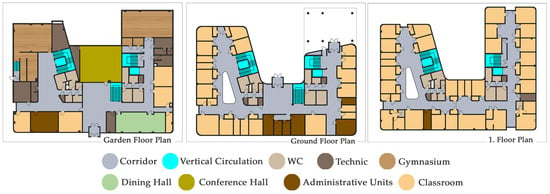
Figure 2.
The ground floor garden level, main floor plan, and first floor plan of the school. A legend has been incorporated, detailing various space types such as classrooms, therapy/rehabilitation rooms, administrative offices, sanitary facilities, circulation areas, and support spaces. As illustrated in Figure 3, outside the schoolyard, there exists a designated drop-off zone for vehicles and school buses that leads to an accessible entrance connected via a gently sloped ramp, thereby ensuring seamless transitions between indoor and outdoor environments. By utilizing the site’s natural topography, the design strategically integrates all building levels with the surrounding landscape, thereby maximizing spatial efficiency. At the rear, a lower garden level accommodates open-air classrooms and an animal interaction area, fostering experiential and nature-based learning. The first floor, elevated on columns, creates a semi-open space that enhances the sense of arrival and functions as a transitional buffer between interior and exterior zones.

Figure 3.
Alternative entrance configurations of the school.
Topographical variations are created through stepped terraces that serve as recreational and sports areas. Safety and accessibility are incorporated into all elevation changes and circulation routes. The spatial layout supports students’ physical and emotional well-being by including biophilic features such as natural materials, vegetation, and opportunities for animal contact, which enhance environmental awareness and foster connections with the natural world.
3.2. Floor Level Changes
Elevation changes can present significant hazards and functional challenges for individuals with special needs. Since many individuals with cognitive disabilities also experience additional physical or sensory impairments, level transitions become a significant barrier to full spatial accessibility [38]. In its published report on accessibility, the Chamber of Architects of Turkey proposed the design solution shown in Figure 4 for open voids and grating systems. The report recommends that the spacing between grates should not exceed 13 mm, and where possible, gratings should be oriented perpendicular to the direction of travel, as this configuration improves safety and mobility performance [38,39].
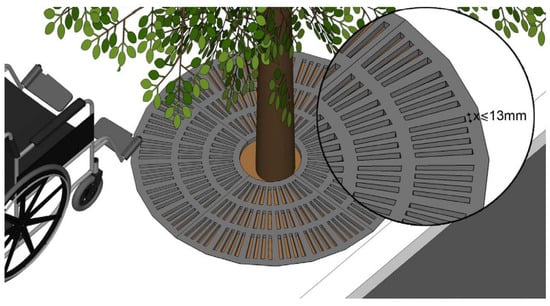
Figure 4.
Example of floor grating.
Interior floor surfaces must be level and continuous, as even slight irregularities can present tripping hazards for individuals with disabilities [38]. Thresholds up to 0.6 cm generally require no intervention, while those between 0.6 and 1.3 cm should include beveled edges with a maximum slope of 1:2. Elevations exceeding this must conform to ramp standards.
Carpeted or textile floor coverings must be securely fixed, slip-resistant, and have a pile height no greater than 1.3 cm. To ensure surface continuity, such coverings should be recessed into the floor [36,39].
At Gülseren Özdemir Special Education Practice School, all interior and exterior circulation areas are designed without level changes. Entrances and interior transitions are entirely flush, and areas with topographical variation, such as garden sections, are safely enclosed. As shown in Figure 5, the facility provides uninterrupted, barrier-free movement throughout.
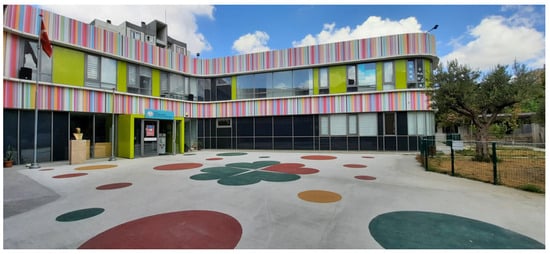
Figure 5.
Garden area of Gülseren Özdemir Special Education Practice School.
The image depicts the central courtyard of the school, designed entirely at grade level to ensure barrier-free access for individuals with special needs. Colorful, tactile ground patterns contribute to sensory stimulation and spatial orientation, while the fenced area on the right encloses a section with topographical variation. The design integrates visual engagement and accessibility, reflecting principles of inclusive spatial planning.
3.3. Obstructions and Projections
Obstacles along pedestrian pathways should be vertically aligned to reduce spatial intrusion and guarantee consistent navigability. Typical examples of collision hazards for individuals with special needs include vegetation, benches, fire hydrants, signage, transit stops, and waste bins. To mitigate these hazards, tactile surface indicators may be installed around these elements to improve spatial awareness and prevent accidents.
An assessment of the physical obstacles and surface projections within Gülseren Özdemir Special Education Practice School indicates that no barriers are present within pedestrian circulation or activity zones. Elements such as vegetation, waste bins, advertising boards, warning signs, and fire hydrants have been deliberately excluded from walkways and movement areas to prevent potential collisions involving individuals with visual impairments or orthopedic disabilities. Figure 6 illustrates that the soft and hard surface zones in the garden area are segregated by fencing, thereby eliminating risks for wheelchair users and ensuring safe, uninterrupted mobility. The main courtyard features a level, barrier-free hard surface that facilitates unobstructed movement. Soil areas and vegetation are clearly demarcated from circulation paths by means of low fencing, thereby enhancing spatial definition and safety for wheelchair users. The absence of ground-level obstacles along the primary walkway contributes to accessible and continuous outdoor mobility.
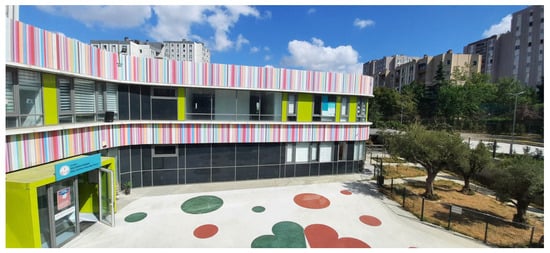
Figure 6.
View of the garden at Gülseren Özdemir Special Education Practice School.
3.4. Doors—Handles and Revolving Doors
For individuals with limited mobility or strength, door design plays a crucial role in ensuring accessibility and physical comfort. Conventional hinged doors can be challenging to operate, making automatic sliding doors a more inclusive alternative [40].
The main entrance should be at least 150 cm wide, with one leaf of double doors no narrower than 100 cm. Thresholds should be avoided; if unavoidable, they must not exceed 1.3 cm and should be beveled to prevent obstruction. Exterior doors must be easy to operate, and revolving doors should be avoided or supplemented by an accessible alternative.
Visual contrast between doors and adjacent walls enhances visibility, while glass doors require safety markings. Interior doorways must offer a minimum clear width of 90 cm, and doors to independent units should be at least 100 cm wide. Minimum door height throughout should be 220 cm [37,39,41].
As shown in Figure 7, door handles must be operable by all users. Spherical knobs are discouraged in favor of lever-type handles, installed at a height of 90–110 cm above the floor. To enhance durability, protective plates are recommended at the base of frequently used doors [37,38].

Figure 7.
Door and accessory alternatives.
An assessment of door design at Gülseren Özdemir Special Education Practice School shows that the main entrance has a double-leaf configuration. In contrast, interior doors are single-leaf and meet recommended sizes. All doors are threshold-free and designed for ease of use, as demonstrated in Figure 8. Clear color contrasts between doors and nearby walls improve visual accessibility. Although protective kick plates are absent, the door handles are ergonomically designed, positioned at 100 cm above floor level, and easy to grasp and operate.

Figure 8.
Door types utilized in Gülseren Özdemir Special Education Practice School.
3.5. Horizontal Circulation
To ensure accessibility within the building, a threshold-free design with minimal level differences should be implemented, or suitable adaptations should be made. The minimum unobstructed corridor width should be 90 cm, with the recommended width being 180 cm. Mechanical installations, radiators, and fire safety equipment should preferably be recessed into the walls [38,40].
As shown in Figure 9, a minimum corridor width of 122 cm is required to allow a person with typical mobility and a wheelchair user to pass each other side by side. A minimum width of 150 cm is also necessary for a wheelchair to make a 180-degree turn. Sufficient space should be provided in the required areas to allow wheelchair users to reverse or turn around [39,41]. Unnecessary recesses and projections should be avoided within the building. The corners of mandatory recesses and projections should be rounded [39].
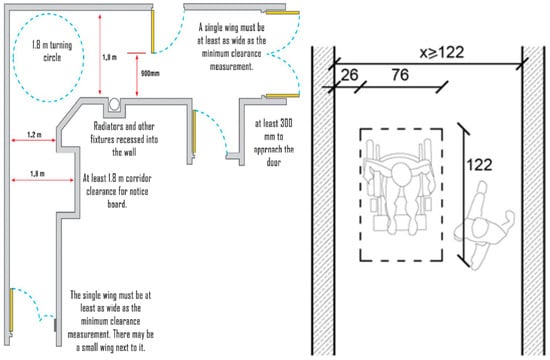
Figure 9.
Corridor layout diagram.
An assessment of the horizontal circulation system at Gülseren Özdemir Special Education Practice School shows that the corridor widths are sufficient. Rest areas have been created by placing seating units along the corridors, as illustrated in Figure 10. There are no thresholds or level differences present.
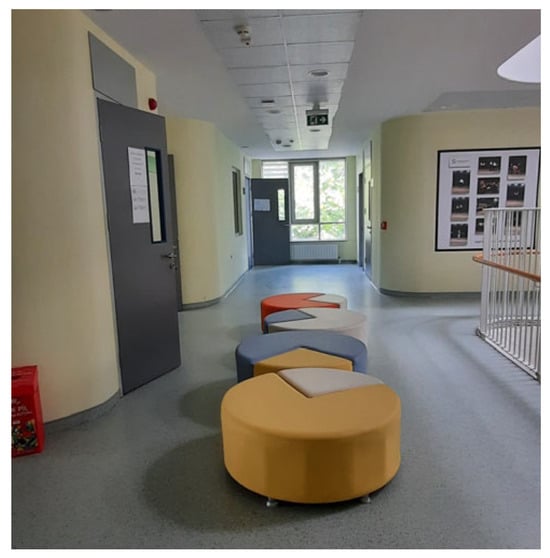
Figure 10.
Corridor area at Gülseren Özdemir Special Education Practice School.
3.6. Ramps
Inclusive ramp design is crucial not only for individuals with orthopedic disabilities but also for those with cognitive impairments, many of whom experience concurrent motor difficulties. Ensuring accessibility for such users necessitates careful consideration of both ergonomic and spatial design parameters.
As illustrated in Figure 11, the usability and safety of ramps vary significantly with slope inclination. While slopes below 4% are considered highly accessible and comfortable, inclinations above 8% require physical assistance and pose risks to independent users. Slopes exceeding 12% are classified as hazardous and are not recommended in any accessible design standard. These classifications emphasize the importance of regulating ramp inclines in educational and public buildings to ensure safe and inclusive environments for all users.

Figure 11.
Slope classification of accessible ramps.
At Gülseren Özdemir Special Education Practice School, only one ramp is located outside the building, designed for students arriving by school transportation. Since there are no thresholds or projections within the structure, the construction of additional ramps has not been deemed necessary. The ramp shown in Figure 12 meets the required dimensions and provides a 5% slope.
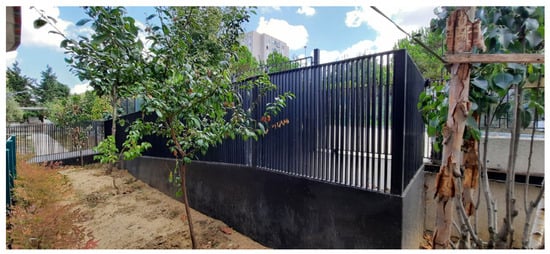
Figure 12.
View of exterior accessibility ramp at Gülseren Özdemir Special Education Practice School.
3.7. Stairs
Stair use presents cognitive and perceptual challenges for individuals with cognitive disabilities, often leading to a reliance on assistance for safe navigation. This issue has been documented in interdisciplinary research, particularly in environmental psychology and inclusive design, which emphasize the critical role of spatial legibility and motor simplicity in supporting autonomous mobility, as illustrated in Figure 13 [37,38,39]. Consequently, the replacement of stairs with ramps, where feasible, is not only a matter of physical accessibility but also one of cognitive inclusion.
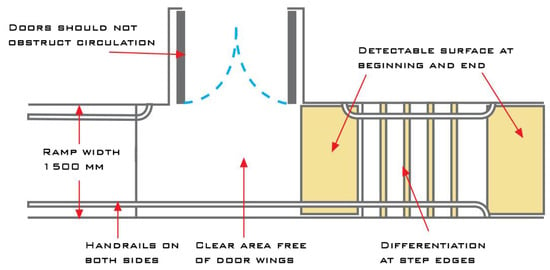
Figure 13.
Stair and ramp configuration.
At Gülseren Özdemir Special Education Practice School, handrails are installed on both sides of the stairs, as shown in Figure 14. The risers are closed, with a height of 16 cm. The stair treads are 150 cm wide and equipped with non-slip bands. Adequately sized landings have been provided. However, tactile surfaces are absent at the beginning and end of the staircase.
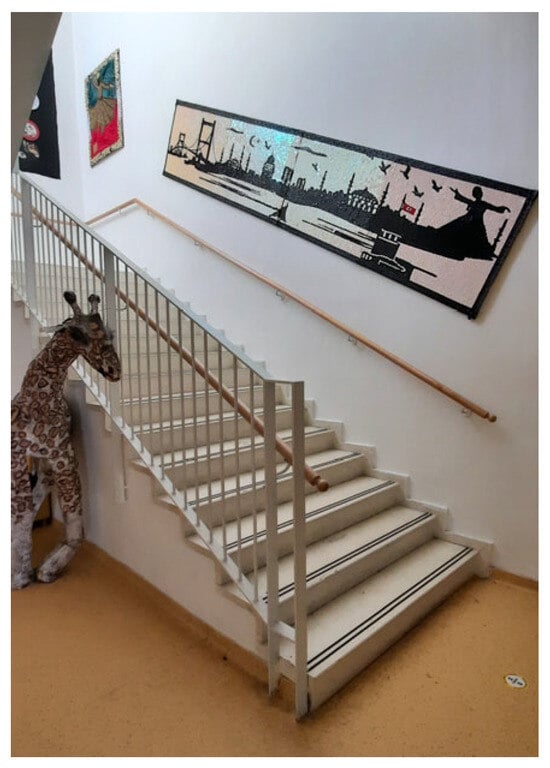
Figure 14.
Staircase at Gülseren Özdemir Special Education Practice School.
The staircase depicted in the image exemplifies adherence to fundamental accessibility principles. Handrails are installed on both sides, and the risers exhibit a consistent height of 16 cm. The treads, measuring 150 cm in width, are equipped with non-slip strips to enhance user safety. Although these features conform to established design standards, the lack of tactile warning surfaces at the top and bottom landings constitutes a deficiency in accommodating the requirements of visually impaired individuals.
3.8. Passenger Lifts (Elevators)
Vertical circulation is a key determinant of accessibility in multi-story buildings. Elevators must be designed to accommodate a wide range of users, including individuals with mobility impairments, visual or cognitive challenges, older adults, and caregivers with strollers. Adequate maneuvering space should be provided in front of the cabin to allow for safe turning for wheelchair users.
Elevator doors should be automatic or motion-activated, with an open duration between 10 and 20 s. Sensors should be located 12–73 cm above floor level to ensure detection by users of all heights. The minimum clear door width must be 90 cm. Call buttons should be positioned at 100 cm and feature high contrast, clear symbols, and tactile indicators. Both auditory and visual signals must be present for effective communication [37,38,39].
Inside the cabin, sufficient space must be available for wheelchair maneuverability. Surface-mounted equipment should not protrude more than 15 mm, and safety features such as a grab bar, a foldable seat, and shatter-resistant mirrors are recommended. Floor level differences between the cabin and corridor should be minimized to prevent tripping hazards. Carpeted flooring is discouraged, and safety equipment such as an emergency phone and surveillance camera should be included [37,42].
At Gülseren Özdemir Special Education Practice School, elevators meet key accessibility standards. There is ample maneuvering space, and the sensor-controlled doors remain open for 10 s. The call button is obvious and accompanied by an auditory signal. Inside, the control panel is user-friendly and placed at an accessible height. The cabin is free of thresholds, accommodates a stretcher, and includes a grab bar and full-length mirror to support spatial orientation. A password-protected system ensures that elevator use is supervised, enhancing student safety.
3.9. Inclined Platform Lift (Platform Stairlift)
Inclined platform lifts offer an alternative vertical circulation solution in buildings where a standard elevator is not feasible due to structural or functional limitations. They are particularly used in existing buildings that have been repurposed as educational facilities for individuals with disabilities.
As illustrated in Figure 15, these lifts are installed parallel to staircases and allow for floor-to-floor movement without requiring conventional elevator shafts. A key principle in their design is to ensure that individuals with special needs can operate the lift independently, without assistance from others. According to accessibility guidelines, the platform surface should not be smaller than 90 cm by 150 cm [39].
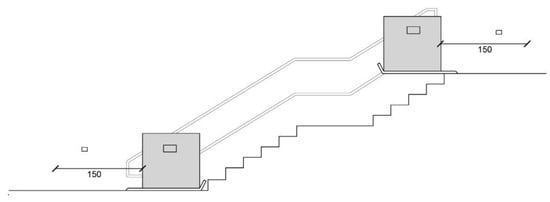
Figure 15.
Inclined platform lift.
At Gülseren Özdemir Special Education Practice School, primary circulation routes are designed without level changes, providing seamless, step-free access that connects entrances, circulation spaces, classrooms, sanitary facilities, and administrative areas. Consequently, the installation of an inclined platform lift was deemed unnecessary. This design decision reflects a proactive and holistic approach to accessibility, recognizing that such lifts involve considerable capital investment and ongoing maintenance obligations. By integrating barrier-free design principles from the outset, the project achieves both functional efficiency and economic prudence.
3.10. Vertical Platform Lift
The spatial positioning of alternative vertical transportation platforms is critical to ensuring accessible circulation within buildings. Sufficient maneuvering space must be provided at entry and exit points on each floor, ensuring that the platform does not obstruct the flow of other users. There must be no level differences between the platform and the adjacent floor surface, and all necessary safety measures must be in place to ensure secure operation [43]. These lifts should not be designed to exceed a vertical travel distance of 2 m. Furthermore, they must be equipped with both audible and visual alert systems, as well as an emergency alarm [38]. While vertical platform lifts are recognized for their role in enhancing inclusive accessibility, such a lift has not been installed at Gülseren Özdemir Special Education Practice School, as the architectural design provides uninterrupted level access throughout, rendering this equipment unnecessary.
3.11. Accessible Toilets
Restroom design in educational facilities must prioritize independent and safe use for individuals with limited mobility, following inclusive architectural standards. At least one accessible toilet should be provided for each gender on every floor, and units should be located in easily reachable, publicly accessible areas.
Single-occupancy, independently accessed restrooms are preferred over integrated multi-user layouts because they better support privacy and caregiver assistance [43]. A minimum clear turning space of 150 cm in diameter, excluding fixtures, must be maintained for wheelchair maneuvering, as illustrated in Figure 16.
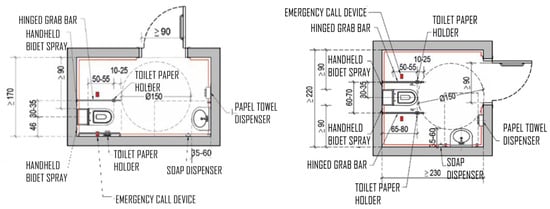
Figure 16.
The layout of an accessible toilet compartment, including required clearances and fixture positions. The design complies with international accessibility standards such as ISO 21542 and ADA 2010.
Doorways should provide a minimum clear width of 90 cm and open outward at no less than 90 degrees. Thresholds should be avoided; if necessary, they must not exceed 6 mm, or 13 mm with a beveled transition (slope no steeper than 1:2). Doors must include emergency override mechanisms and visual occupancy indicators [37,38].
To minimize sensory discomfort, high-decibel flush systems and electric hand dryers should be avoided. Fixtures must be operable with minimal force, and an intuitive, easily accessible emergency call device must be installed inside each unit [39,43].
For accessible restrooms, washbasins must be wall-mounted with no cabinetry beneath to ensure unobstructed wheelchair access. Basins should have rounded edges to minimize injury risk and facilitate ease of use. Grab bars must be installed on both sides of the basin for added support [37,39,43]. Considering that wheelchair users’ eye level typically falls between 110 and 130 cm, the bottom edge of the mirror should be mounted at 90 cm above the finished floor. Tilted or height-adjustable mirrors are recommended for enhanced visibility.
At Gülseren Özdemir Special Education Practice School, accessible restrooms are available on each floor, with threshold-free entry and both multi-user and individual units provided. Single-user restrooms include a shower area, open washbasin access, and sufficient lateral clearance beside the toilet for side transfers. As shown in Figure 17, washbasin edges are rounded to improve safety during approach. In student restrooms, the washbasin height has been lowered to suit the user age group, removing the need for tilted mirrors. However, in adult-accessible units, mirrors are installed at a 15–30° tilt to ensure visibility from a seated position. Shower enclosures are made from tempered glass, which is stronger than standard glass but still subject to shattering. For improved safety, acrylic-based alternatives such as plexiglass (mica) are recommended.
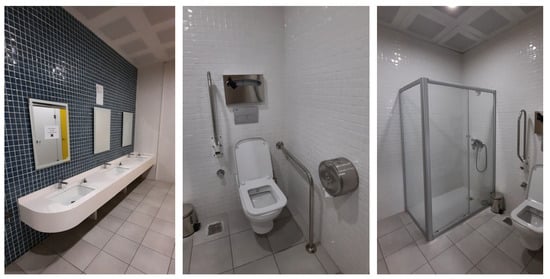
Figure 17.
Toilet unit at Gülseren Özdemir Special Education Practice School.
The unit includes several accessibility-compliant features, such as a threshold-free entrance, lateral clearance adjacent to the toilet bowl, a washbasin with rounded edges, and unobstructed under space to allow for wheelchair access. The basin height appears to have been lowered to accommodate the age range of student users, and the mirror is installed at a fixed angle without a forward tilt, which aligns with the lowered visual axis of younger individuals.
At Gülseren Özdemir Special Education Practice School, accessible restrooms specifically designed for individuals with special needs are equipped with features including vertical and horizontal grab bars, shower facilities, and angled mirrors. In contrast, multi-stall toilets contain standard fixtures appropriate to the users’ age group and basin height, but these lack specialized accessibility features. This spatial organization reflects the school’s commitment to providing an inclusive and accessible physical environment tailored to diverse user needs.
3.12. Handrails and Guardrails
Vertical circulation remains one of the most critical challenges in creating accessible environments for individuals with disabilities. Ensuring the safety and usability of ramps and staircases requires adherence to specific technical standards, particularly regarding handrails and guardrails [37,41].
At Gülseren Özdemir Special Education Practice School, vertical circulation elements have been thoughtfully integrated to meet both functional and safety requirements. All staircases are equipped with aluminum handrails on both sides, featuring circular profiles for ergonomic grip and mounted at a distance from adjacent walls to facilitate ease of use. Handrails are visually contrasted against background surfaces to enhance visibility for users with visual impairments, and tactile or visual markers indicate their start and end points.
Guardrails are installed along all open edges to prevent falls. In interior courtyards, which are designed to enhance natural ventilation and daylight access, the standard guardrail height has been increased to 120 cm to meet user-specific needs, as shown in Figure 18. These openings are also enclosed with tensile safety nets, serving as a passive fall protection measure to prevent users or objects from falling from heights.
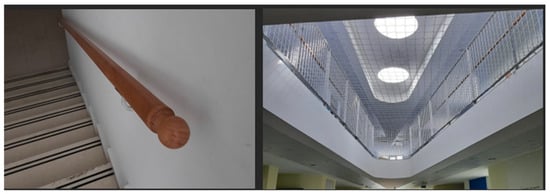
Figure 18.
A wooden handrail with a circular cross-section, featuring an ergonomic grip profile and rounded terminus, is installed along the staircase wall. A passive safety net extends across the atrium voids to prevent the fall of users or objects.
3.13. Surface Finishes
To support safe and autonomous mobility for individuals with physical disabilities, flooring in all built environments should comply with key universal design principles. Surfaces must be stable, firm, and slip-resistant under both wet and dry conditions. Where carpeting or similar materials are used, they must be securely fixed and should not exceed a thickness of 1.3 cm, in accordance with international accessibility standards. Furthermore, flooring is equally critical in outdoor spaces, especially along pedestrian pathways, where materials should be hard, continuous, and free of loose aggregates. For instance, gravel surfaces can present insurmountable barriers for users with limited mobility or those using assistive devices [37,38,39,43]. These spatial strategies are essential for implementing inclusive design and fostering universally navigable environments.
The architectural layout of Gülseren Özdemir Special Education Practice School incorporates flat, stable, and durable flooring materials throughout all interior spaces. No carpeting or similar floor coverings have been applied. Instead, flooring types have been selected in accordance with the specific functional requirements of each space. While PVC flooring provides a modest enhancement in reducing impact noise, such as footsteps or furniture movement, its effectiveness is significantly inferior to that of alternative materials, such as carpeting [44]. As noted by Long [45], resilient floor coverings, including vinyl and linoleum, offer only limited improvements in impact sound insulation and minimally absorb airborne noise. Consequently, PVC flooring cannot substantially decrease ambient noise levels, and its contribution to overall acoustic comfort remains limited. It should be supplemented with additional sound-absorbing measures where appropriate.
As illustrated in Figure 19, the school’s interior entrance is fitted with uniform PVC flooring that provides a smooth, matte surface, effectively minimizing tripping hazards and supporting safe circulation. However, the absence of tactile indicators or directional floor elements restricts accessibility for individuals with visual impairments. In the adjacent outdoor area, the concrete surface is enhanced with brightly painted circular motifs. While visually stimulating, these decorative elements lack functional zoning and tactile differentiation. Without clearly defined spatial boundaries, individuals with sensory or cognitive disabilities may face difficulties in spatial orientation and independent movement.

Figure 19.
Interior and exterior flooring at main entrance of Gülseren Özdemir Special Education Practice School.
3.14. Built-In Fixtures
Electrical outlets within the building should be installed at a minimum height of 40 cm above the finished floor level. Switches and sockets are preferably aligned with door handles or placed at a height between 90 and 110 cm to ensure ease of use. For wheelchair users, outlets should be positioned at least 35 cm away from wall corners to allow for unobstructed access. To improve visual detectability, electrical fixtures should exhibit chromatic contrast with the surrounding wall surface [38,43].
As illustrated in Figure 20, the electrical outlets are mounted approximately 40 cm above the finished floor level and are visually integrated with the adjacent wall surfaces. Although this reflects a general consideration of accessibility guidelines, the lack of chromatic contrast and their proximity to wall corners may limit visibility and reach, particularly for users with visual or mobility impairments. These observations suggest that inclusive design principles have not been consistently applied across classroom infrastructure.
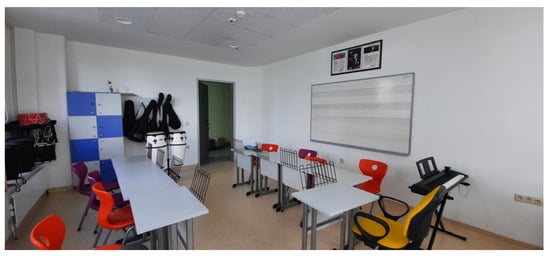
Figure 20.
Wall-mounted electrical outlets and low-contrast placement in a music classroom at Gülseren Özdemir Special Education Practice School.
3.15. Design Simplicity and Minimal Detailing
Individuals with cognitive disabilities often have difficulty interpreting spatial layouts, shapes, and auditory cues. Environments that are visually complex or poorly organized can cause confusion and discomfort. In contrast, calm, clear, and well-structured spaces boost users’ feeling of safety and ease of use. A minimalist design, characterized by reduced visual clutter and simplified spatial cues, enhances environmental clarity and supports cognitive accessibility [46].
At Gülseren Özdemir Special Education Practice School, the interior design reflects a conscious effort to minimize visual complexity. While the exterior façade features more dynamic visual elements, the interior adopts a uniform material and color palette. Flooring and baseboards are tone-matched, and wall finishes use neutral, monochromatic hues to reduce perceptual distractions. This design strategy enhances spatial legibility and fosters a cognitively supportive environment, particularly for users with neurodiverse needs.
3.16. Signage
Informational signage is essential for safe and independent navigation in educational settings. Directional and warning signs should be clear, concise, and universally understandable, with high contrast between the content and background. Typography must be legible from appropriate distances, and visual clutter from excessive signage should be minimized. Materials should be durable, easy to maintain, and suitable for high-traffic areas [39,43].
Essential signage in schools includes clearly marked routes to elevators and restrooms. When elevators are not directly visible from the main entrance, wayfinding signs should guide users from entry points to vertical circulation cores. Restroom signage should be immediately visible and positioned for intuitive recognition.
Placement is also critical: signage may be wall-mounted, ceiling-suspended, mobile, or integrated into the floor. Ceiling signs must be mounted at a minimum height of 220 cm to remain visible without obstructing circulation. Tactile signs and braille panels should be positioned between 120 and 160 cm above floor level to remain accessible for wheelchair users and individuals with visual impairments [39,43].
As illustrated in Figure 21, the school employs ceiling-mounted exit signage that meets visibility requirements through proper height placement and standardized pictograms. However, directional signage guiding users to functional areas, such as classrooms or service rooms, is absent. While room identification panels are present beside doorways and positioned at accessible heights, they do not seem to include tactile or braille features. The signage system, although partially implemented, lacks the comprehensiveness needed to support independent wayfinding for users with cognitive or sensory impairments. An integrated approach to visual and tactile signage would enhance spatial orientation and promote equitable access throughout the facility.
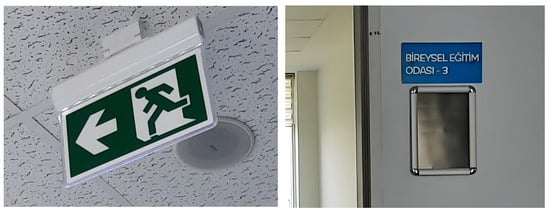
Figure 21.
Ceiling-mounted exit signage and wall-mounted room identification panel at Gülseren Özdemir Special Education Practice School.
3.17. Furniture, Fixtures, and Equipment (FF&E)
Furniture and fixtures must accommodate both individuals with disabilities and general users, as physical ability affects spatial comfort and autonomy [47]. Anthropometric compatibility is essential, and adjustable elements such as height-adaptable chairs and tables are recommended.
Spatial arrangement is also vital. Classroom layouts should enable teacher control while allowing students clear access. The U-shaped table setup (Figure 22) shows this balance. Since individuals with Down syndrome often face attention challenges, keeping the environment clean and uncluttered to reduce visual distractions is essential. Stimulating surfaces like display boards should be placed behind students to avoid overload [48,49]. Also, enclosed storage units are better than open shelves to help focus by minimizing visual distractions [50].
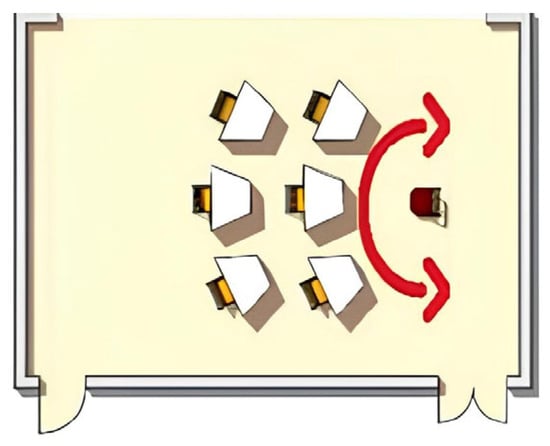
Figure 22.
Suggested U-shaped classroom layout to enhance teacher accessibility and student focus.
As illustrated in Figure 23, the classroom furniture at Gülseren Özdemir Special Education Practice School features oval-edged tables and chairs to reduce the risk of injury. The environment avoids visually distracting or overly colorful elements, with enclosed student storage units aligning with best practices to minimize cognitive overload. This simple, uncluttered design supports the needs of students with special requirements.
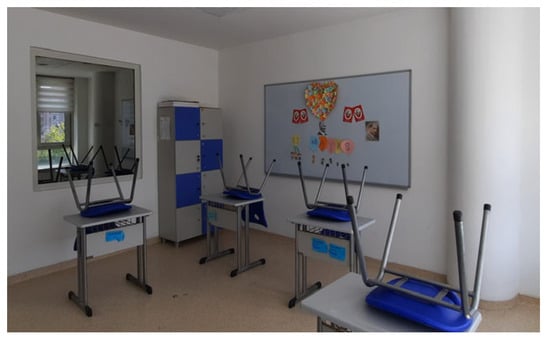
Figure 23.
Interior classroom furnishings featuring enclosed storage units, round-edged desks, and minimal visual clutter at Gülseren Özdemir Special Education Practice School.
Due to the summer break, actual seating arrangements were not observed; however, classrooms are spacious enough to allow for flexible layout changes. While most desks and chairs do not have height adjustability, the furniture is generally ergonomic. Still, the widespread use of rigid plastic chairs could affect long-term comfort. Adding adjustable seating is recommended to improve inclusivity and meet individual needs.
As illustrated in Figure 23, the classroom layout incorporates key design principles that enhance safety and cognitive accessibility. Rounded-edge desks reduce injury risk, particularly for students with motor challenges. Enclosed lockers minimize visual clutter, supporting cognitive focus by limiting environmental overstimulation. The restrained use of decorations and strategic placement of the visual board further promote a distraction-free learning environment. Together, these elements demonstrate an evidence-based approach that prioritizes both physical safety and cognitive comfort for students with special needs.
3.18. Lighting
Lighting plays a crucial role in educational environments, directly impacting the effectiveness of teaching and learning processes. Well-illuminated spaces enhance visual performance and support more efficient reading and writing acquisition [51]. Improving visual comfort and spatial legibility is particularly important for individuals with cognitive or sensory sensitivities, as it aids orientation, reduces stress, and enhances overall usability in educational spaces.
Glare and reflections can cause visual confusion. To reduce this, matte finishes are better than glossy surfaces. Uniform lighting should be prioritized because shadows and beams of light might be misperceived by people with cognitive or sensory sensitivities. Since each room has different functional needs, lighting strategies should be customized accordingly. Maintaining consistent visual comfort involves balancing changes in natural daylight with artificial lighting [38].
Natural light, in particular, provides proven psychological benefits. Insufficient exposure has been linked to an increased risk of depression. Besides enhancing spatial perception, daylight aids emotional regulation in individuals with neurodiverse profiles. Flickering fluorescent or high-intensity spotlights can lead to sensory discomfort, making dimmable systems a more inclusive option.
Fixtures should be non-intrusive and seamlessly integrated into the spatial layout. Well-lit educational environments optimized for natural daylight exposure contribute to improved attention regulation and emotional stability in learners with Down syndrome, supporting both cognitive performance and psychological comfort [46].
The lighting at Gülseren Özdemir Special Education Practice School is provided by recessed LED spotlights installed in suspended ceilings, featuring daylight-colored luminaires (4000–5000 K). These fixtures emit low levels of radiation and generate minimal heat compared to conventional lighting solutions. Unlike fluorescent systems, LED lighting is flicker-free, which reduces visual fatigue and promotes sustained visual comfort. Furthermore, the incorporation of dimmable systems and indirect lighting is suggested to enhance adaptability and user comfort.
As shown in Figure 24, circular skylights integrated into the first-floor ceiling introduce ample natural light into the central atrium. These glazed roof openings function as daylight wells, allowing sunlight to spread across multiple levels, including the ground and garden floors. During daytime hours, these areas do not require artificial lighting. Furthermore, large window openings throughout the building ensure consistent access to natural light, maximizing its rehabilitative potential. The combined use of artificial and natural lighting results in well-balanced illumination, enhancing both spatial legibility and the psychological well-being of users with special needs.
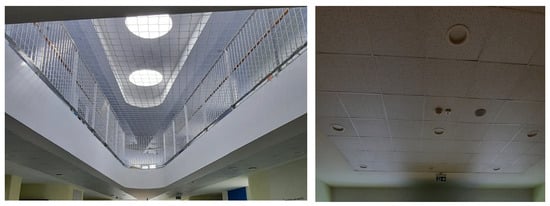
Figure 24.
Skylight-integrated atrium and recessed artificial lighting fixtures at Gülseren Özdemir Special Education Practice School.
3.19. Color Strategy
Color significantly influences individuals’ physical energy, emotions, concentration, creativity, and spatial interaction by affecting sensory perception, brain activity, and hormonal responses [52,53]. For individuals with special needs, color enhances visual cognition, spatial orientation, and wayfinding by increasing environmental legibility and aiding recognition of architectural elements such as doors, handles, and switches [38]. When applied thoughtfully and in moderation, color serves as a valuable perceptual cue that supports independence and comfort.
In educational settings, appropriate color variation encourages creativity and cognitive engagement while reducing spatial monotony. However, using more than six dominant hues excessively may impair cognitive processing, especially among learners with neurodevelopmental conditions [52]. Therefore, color palettes should focus on perceptual clarity and emotional regulation rather than decorative excess. Classrooms for students with Down syndrome or cognitive differences benefit from color schemes that enhance spatial cues and promote emotional safety. Purposeful contrasts, subtle directional cues, and harmonious hues increase engagement and support learning [54].
At Gülseren Özdemir Special Education Practice School (Figure 25), the vibrant, multi-colored exterior contrasts with the neutral and subdued interior palette. While high-saturation colors add energy to the façade, their use indoors may overstimulate students with neurodevelopmental sensitivities. Inside, soft neutrals create a calming base, supported by contrasting accents such as orange to aid visual orientation. Color-coded corridors enhance wayfinding and spatial comprehension.
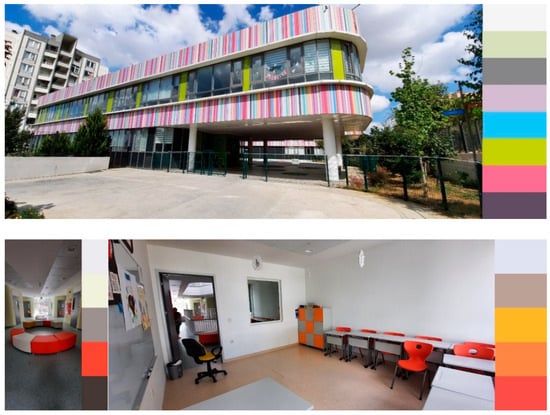
Figure 25.
Controlled use of orange and complementary color palettes in the façade, classrooms, and circulation areas of Gülseren Özdemir Special Education Practice School, supporting spatial orientation and emotional stimulation without overstimulation.
Orange is strategically applied as a stimulating yet controlled accent, enhancing alertness and mood without causing sensory overload [55]. Its selective use in circulation spaces at the school exemplifies a careful balance between emotional stimulation and cognitive clarity, reflecting an informed integration of color psychology within inclusive design.
3.20. Thermal Comfort
Thermal comfort refers to a psychological and physiological state in which individuals experience no discomfort related to temperature, humidity, or air movement [56,57]. Deviations from optimal conditions may impair cognitive and physical performance. Excessive heat causes fatigue, while low temperatures reduce attention and productivity [56]. Thus, effective climate control is vital in educational settings to maintain conducive learning conditions and support student motivation.
Indoor air quality is equally crucial, directly influencing health and academic outcomes. According to the U.S. Environmental Protection Agency [58], poor air quality in schools contributes to absenteeism and health issues such as respiratory infections, allergies, and attention deficits [52]. Inadequate ventilation fosters humidity buildup and mold growth, damaging both occupants and building materials. Regular ventilation during colder months and maintaining indoor temperatures around 18 °C are recommended for thermal comfort during instructional periods.
For individuals with special needs, who often exhibit increased sensitivity to environmental discomfort, maintaining stable thermal and air quality conditions is particularly important to prevent stress, support concentration, and encourage engagement. Educational facilities must thus prioritize integrated management of temperature, ventilation, and humidity to promote inclusive usability and well-being.
At Gülseren Özdemir Special Education Practice School, heating is provided via a central radiator system, while classrooms lack mechanical cooling and rely on natural ventilation for air quality. Given the regional climate and academic calendar, this approach appears appropriate. Split-type air conditioners are installed only in administrative offices, which operate year-round, including warmer months.
3.21. Acoustic Comfort
Auditory comfort in interior environments requires the even distribution of sound and the minimization of noise, achieved through a well-designed acoustic environment and the integration of sound-insulating materials within the building envelope [56]. Acoustic comfort is a vital aspect of contemporary educational design, encompassing not only sound insulation but also impact and vibration damping. Recommended strategies include resilient flooring underlayment to absorb impact noise, acoustic insulation in interior and exterior walls, and the installation of perforated or sound-absorbing ceiling materials [59].
These considerations are particularly critical for individuals with autism spectrum disorder, who are often hypersensitive to auditory stimuli and may struggle to differentiate between sounds [46]. Proper acoustic performance is essential to fostering a comfortable and supportive learning environment, as noise and poor acoustics can adversely affect physical and psychological well-being, potentially causing hearing problems, fatigue, stress, headaches, impaired concentration, and diminished educational outcomes [56].
At Gülseren Özdemir Special Education Practice School, acoustic performance was addressed systematically during the construction phase. Interior and exterior wall assemblies were designed with appropriate insulation materials to limit airborne sound transmission, while PVC flooring was employed primarily for its capacity to reduce impact noise. To enhance sound absorption within learning environments, suspended ceilings incorporating perforated panels and mineral wool infill were installed. In wet areas, clip-in metal ceiling systems were selected to resist moisture-induced degradation, thereby supporting both the durability of acoustic materials and the long-term integrity of the building envelope. These observations are qualitative; in the absence of instrumental testing, quantitative acoustic performance could not be verified.
4. Discussion
4.1. Rationale and Methodological Framing
The impact of architectural spaces on human behavior is well recognized in modern environmental psychology and spatial theory; extending beyond aesthetic or technical concerns, architectural design increasingly operates as a social determinant of health, inclusion, and dignity. This perspective is especially vital in educational environments designed for individuals with Down syndrome, who experience a complex interplay of cognitive, sensory, and physical challenges. Educational spaces created for individuals with Down syndrome are essential in helping these individuals reach their full potential.
This study aims to expand the discourse beyond the commonly emphasized concept of accessibility in the literature by evaluating special education facilities through a more holistic framework informed by the principles of building biology. Within this framework, variables categorized under spatial–formal, visual, acoustic, and climatic comfort were examined in relation to the cognitive, physical, and sensory needs of individuals with Down syndrome, using Gülseren Özdemir Special Education Practice School as a case study.
4.2. Design Challenges and Observations
In this study, field research was guided by literature-based findings regarding the specific needs of individuals with Down syndrome. Based on these findings, as well as on-site observations, spatial plan analyses, and user-centered evaluations conducted by the authors, the following interpretations have been developed:
4.2.1. Meltdowns and Self-Injurious or Aggressive Behaviors
Meltdowns are among the most frequently observed behavioral challenges in individuals with Down syndrome. Given the potential for self-injurious or aggressive behaviors during such episodes, educational spaces must incorporate specific safety-oriented design strategies. In the examined case study, various spatial precautions addressing this need were identified. Notably, the widespread use of rounded wall corners throughout the building reduces the risk of injuries resulting from collisions or falls and is considered an effective preventive measure.
Avoiding sharp-edged or pointed furniture and fixtures serves as a risk mitigation strategy that enhances user safety. A balanced interior color palette consisting of calming tones supports emotional regulation, especially for students with sensory processing sensitivities. Conversely, the exterior façade features vivid and high-contrast colors that can cause visual overstimulation and cognitive confusion, particularly for users with perceptual processing differences. This discrepancy emphasizes the need for a consistent chromatic language throughout the architectural environment to promote behavioral and perceptual stability.
4.2.2. Physical Disabilities and Spatial Accessibility
Motor development limitations commonly observed in individuals with Down syndrome pose significant physical challenges that require specific spatial design considerations. Although most of these individuals are not formally classified as mobility-impaired, physical characteristics such as hypotonia, balance difficulties, and coordination deficits highlight the importance of implementing universal design principles to ensure multidimensional accessibility.
In the case of Gülseren Özdemir Special Education Practice School, accessibility features like ramps, elevators, staircases, and handrails have been incorporated into the building layout to support both horizontal and vertical movement. This shows a commendable commitment to basic accessibility standards for circulation areas. However, the interior furnishings, including desks and chairs, lack ergonomic and adjustable features that address the physical diversity of users with special needs. This limitation reflects a broader disregard for individual differences and the possibility of co-occurring disabilities. Since physical suitability encompasses not only spatial access but also functional usability and comfort, the interior fit-out must be reconsidered through a more inclusive and user-centered perspective.
4.2.3. Physical Disabilities and Fixture Compatibility
Individuals with Down syndrome often exhibit hypotonia, muscle weakness, joint laxity, and difficulties with motor coordination, all of which directly impact spatial mobility. While they are not typically classified as mobility-impaired, architectural environments that accommodate these physical characteristics can significantly enhance both the safety and effectiveness of educational processes. Furthermore, the possibility of multiple co-occurring disabilities highlights the necessity for flexible and inclusive spatial strategies in the design of educational facilities.
In the analyzed case study, the building meets basic requirements for horizontal and vertical circulation by incorporating accessibility features such as ramps, elevators, staircases, and handrails. However, when evaluated in terms of interior furnishing, the environment lacks adjustable and ergonomically appropriate fixtures that accommodate diverse physical needs. The exclusive use of standardized desks and chairs fails to address variations in users’ anthropometric dimensions and sitting postures, resulting in limited functional comfort. This observation highlights that spatial accessibility should not be limited to circulation zones alone but must also encompass all physical elements that mediate user–environment interaction. In educational settings, furniture systems designed with modular, adjustable, and user-centered principles can enhance physical comfort while promoting autonomy and self-efficacy among students.
4.2.4. Sensory Accessibility in the Context of Visual and Auditory Impairments
Sensory sensitivities or impairments related to vision and hearing are commonly observed among individuals with Down syndrome. This condition necessitates designing educational environments not only for physical accessibility but also with careful attention to sensory accessibility. Moreover, considering the potential presence of multiple disabilities in this population, educational spaces must engage various sensory channels in alignment with inclusive design principles.
In the case study, visual and auditory guidance elements were incorporated only to a limited extent. While some graphical signage was available to help with navigation, these elements were found to be inadequate in size, contrast, and placement. For example, the signage did not sufficiently accommodate users with different levels of visual perception, as it lacked proper scale and positioning. Additionally, tactile signage, audible alerts, and detectable surfaces were mainly absent or limited in implementation. Lighting quality, a key part of visual perception, warrants separate discussion within sensory accessibility. Adding architectural features like skylights to improve natural light is a positive design feature. Artificial lighting systems were generally designed with suitable color temperature and brightness for each space’s use. However, the lighting conditions were not adjustable to meet individual user preferences or needs. In this context, adding dimmable systems that let users adjust light levels could provide a more flexible and inclusive lighting environment. Overall, enhancing sensory accessibility through various visual and auditory cues would allow individuals with special needs to interact with the built environment more safely and clearly. This approach not only reinforces spatial legibility but also promotes user autonomy and emotional security.
4.2.5. Perceptual Legibility Within the Context of Cognitive Disabilities Context
Cognitive developmental delays, which are commonly observed in individuals with Down syndrome, can lead to significant difficulties in environmental perception and spatial orientation. This underscores the importance of perceptual legibility in designing educational environments, necessitating spatial clarity, simplicity, and functional differentiation as core design principles. The strategic use of color as a visual cue, along with the intentional differentiation of architectural elements such as doors and windows from adjacent surfaces, plays a crucial role in facilitating wayfinding.
Such strategies exemplify visual coding methods that enhance spatial orientation. In the examined school building, color was used consciously as a perceptual aid in multiple areas. Beyond its role as a visual differentiator, color was also applied with attention to its psychological effects. Architectural elements such as doors and windows were designed in contrasting colors relative to the surrounding wall surfaces to improve perceptibility. Moreover, functional zoning was maintained by avoiding multi-purpose spatial configurations, which helped strengthen the legibility and distinctiveness of individual areas.
4.2.6. Spatial Design and Acoustic Comfort for Hyperactivity
Hyperactivity is a common behavioral trait observed in individuals with Down syndrome, necessitating targeted spatial interventions. In the school environment examined, calming rather than stimulating colors were intentionally selected for interior spaces to promote tranquility and emotional regulation. This approach fosters the development of environments that support balanced behavior.
Given the likelihood of elevated noise levels due to high physical activity, enhanced acoustic design strategies were implemented. In the sensory integration classroom, soft flooring was used to reduce footfall noise, while sound-absorbing wall finishes helped to minimize reverberation. Additional interior spaces feature sound-insulating wall assemblies and upholstered or fabric-covered panels to dampen disruptive noise. Although technical acoustic measurements were not conducted, these interventions reflect architectural efforts to create a more acoustically comfortable environment for users with diverse sensory sensitivities. The approach centers on spatial layout and material selection rather than engineering-based acoustic modeling. Further safety-related design measures include the exclusion of sharp-edged elements, elevated window placement to prevent injury, and the development of flexible classroom layouts with a maximum of ten students per class to support attention and reduce overstimulation.
4.2.7. Attention Deficits and the Role of Environmental Comfort
Attention deficits are often observed among individuals with Down syndrome and require careful environmental planning in educational settings. Design elements such as lighting, color selection, furniture layout, acoustic treatment, and climate control play a crucial role in minimizing distractions and supporting sustained attention. Therefore, maintaining a high level of environmental comfort is a fundamental strategy for mitigating attention-related difficulties.
In the analyzed facility, both natural ventilation and air conditioning systems are present. However, maintaining a consistent balance of humidity and temperature is essential for achieving optimal thermal comfort. The provision of fresh air and the expulsion of stale air have become critical design priorities, particularly in the post–COVID-19 context. Where natural ventilation is insufficient, the integration of mechanical systems becomes necessary. While the glass openings in the ceiling effectively introduce daylight into interior spaces, they may also cause a greenhouse effect during the summer months, which can compromise thermal regulation. For this reason, supplementary measures such as smart glass technologies, sunshading devices, or automated blinds are recommended to reduce interior heat gain and maintain thermal stability.
4.2.8. Self-Care Essentials and Supportive Spatial Interventions
Self-care neglect, frequently observed among individuals with Down syndrome, underscores the necessity for hygienic spaces that are thoughtfully designed within educational environments. In the examined facility, restrooms have been implemented according to the standards defined in the relevant literature. Additionally, integrated shower cabins are available to support hygiene-related needs. However, from a safety perspective, the use of tempered glass enclosures may pose risks in the event of accidental impact. Alternative materials such as acrylic or polycarbonate are recommended due to their lower injury potential. In contrast, the cafeteria area lacks spatial arrangements tailored to users with special needs, reflecting instead the requirements of a standard user profile. Supportive interventions during mealtimes, such as ergonomic seating, user-centered wayfinding, and spatial adaptations, help promote autonomy and strengthen social integration for individuals with developmental disabilities.
4.3. Synthesis with Interdisciplinary Literature
Based on these observed strengths and limitations, the overall implications of the findings become clearer when evaluated alongside recent interdisciplinary research. The field findings reveal consistent gaps in lighting, acoustics, ventilation, and spatial flexibility, which align with previous studies on the sensory and functional needs of students with intellectual disabilities, including those with Down syndrome. Suraini et al. [8] and Coyne et al. [9] emphasized the importance of multisensory spatial features and universal design to support cognitive accessibility. These gaps were also associated with a lack of natural views and visual cues for orientation, confirming Li and Sullivan’s [12] findings on landscape exposure reducing stress. Eitland et al. [11] further connected indoor environmental quality to student health and academic success, both of which were affected in the case school. Page et al. [10] highlighted inclusive spatial strategies that foster a sense of belonging, which was lacking in several critical areas. Overall, the findings underscore the importance of implementing a comprehensive design approach rooted in building biology and supported by empirical assessments conducted in the field. These observations expand upon recent interdisciplinary research and highlight the need for a paradigm shift in the design of educational settings for individuals with intellectual disabilities. The role of national frameworks was clarified by noting that the school design goes beyond compliance with these standards. Instead of depending solely on isolated accessibility enhancements, a system-oriented and health-centered model presents a more effective framework. This study advocates a transition from compliance-driven solutions to responsive, inclusive, and health-promoting spatial strategies that actively support and empower learners with Down syndrome.
4.4. Toward a Building Biology-Oriented Design Paradigm
Rather than adopting isolated accessibility upgrades, a systems-based approach rooted in building biology emerges as a more holistic and health-centered model. This study underscores the need to transition from compliance-driven design toward responsive, inclusive, and health-promoting spatial strategies that actively accommodate and empower learners with Down syndrome. Overall, these findings support a comprehensive, human-centered, and evidence-driven spatial approach that integrates environmental psychology, building biology, and universal design. Aligning with recent academic critiques, this study recommends an integrative design framework as a fundamental method for creating inclusive educational architecture.
This integrated approach underscores the necessity of reimagining existing educational environments as more inclusive, adaptable, and user-centered. Although the current study centers on post-occupancy spatial evaluation, several limitations have been identified, particularly related to interior furniture systems, rigid spatial configurations, and fixed lighting schemes. These constraints indicate opportunities for future improvements, such as incorporating height-adjustable, anthropometrically responsive furniture, adopting flexible zoning-based classroom layouts, and implementing user-controlled lighting tailored to individual sensory needs. Importantly, these spatial adaptations should address not only physical accessibility but also psychological well-being by fostering feelings of safety, environmental control, and belonging. Aligned with adaptive architecture principles, such interventions enhance functional usability alongside personal autonomy and emotional health. Grounded in building biology, this framework aspires to develop educational settings that operate as responsive ecosystems, accommodating diverse physical, cognitive, and sensory requirements.
4.5. Implications and Design Recommendations
Designing learning environments for individuals with Down syndrome requires moving beyond regulatory compliance to address the specific cognitive, sensory, and behavioral characteristics of this user group. A user-centered approach, informed by the principles of Universal Design for Learning, emphasizes perceptual clarity, sensory accessibility, and equitable usability [60,61]. Inclusive spatial strategies promoted by organizations such as NDSS and DSEI [62] support autonomy, active participation, and well-being.
Drawing on field observations and the spatial deficiencies identified in the case study, the following recommendations are proposed.
4.5.1. Visual Contrast for Perceptual Legibility
High visual contrast should be incorporated into elements such as light switches, power outlets, and signage to enhance spatial legibility for users with low vision. In line with the ADA Standards [31] and the Department of Transportation (DOT) Guidelines [63], the use of light-on-dark or dark-on-light formats is essential for ensuring visual clarity. Additionally, stair treads should include contrasting nosings to improve depth perception and support safer navigation.
4.5.2. Tactile Navigation Aids
Tactile surfaces and textured pathways are essential in supporting spatial orientation for visually impaired users. These features increase safety and autonomy by conveying spatial cues through foot or cane contact [64].
4.5.3. Acoustic Optimization for Cognitive Engagement
4.5.4. Ergonomic and Inclusive Furniture
Classroom furniture should be designed in accordance with anthropometric data and national accessibility standards to promote proper posture, comfort, and usability for all students, including those with mobility impairments. Features such as height-adjustable desks and chairs facilitate accommodation of different body sizes and mitigate discomfort caused by poor sitting posture. Research indicates that discrepancies between students’ body measurements and furniture can lead to discomfort and improper postures, potentially affecting engagement and concentration [66]. These findings underscore the need for inclusive, adjustable furniture solutions tailored to diverse user profiles. In Turkey, the TSE 9111 [41] standard recommends that classroom desks be adjustable between 700 and 850 mm, ensuring accessibility for wheelchair users, and advocates seating arrangements that minimize physical strain during prolonged use [67].
4.5.5. Clear and Intuitive Graphical Signage
Graphical signage should be not only visually contrasting but also cognitively clear, using universally recognizable symbols and simplified imagery to promote intuitive navigation and orientation. This design strategy aligns with established accessibility and international standards, which highlight high visual contrast [31,63] as well as clear and recognizable symbols [68,69].
These strategies form an integrated framework aligned with universal design and building biology principles, enabling inclusive and health-supportive learning environments.
4.6. Limitations of Study
This study focused on a single educational institution and used qualitative field observations, which could limit how broadly the findings apply to other areas. Dependence on research interpretation adds a level of subjectivity, and the lack of automated measurement tools might impact the objectivity and ability to replicate some assessments. Furthermore, direct user interviews were not conducted due to ethical constraints associated with working with a vulnerable population. Instead, this study employed an indirect user representation strategy by grounding spatial decisions in a literature-based analysis of the behavioral patterns, sensory sensitivities, and condition-specific needs of individuals with Down syndrome. This approach enabled the development of evidence-informed design solutions while maintaining ethical responsibility. Additionally, this study did not incorporate comparative case studies or control buildings, which limits the generalizability of the findings. This aspect has been identified as a priority for future research. This study did not include empirical assessments of indoor pollutants, radon levels, or the performance of building services, as these parameters fall beyond the defined scope of the current investigation. However, their significance is fully acknowledged, and they are identified as key priorities for future research aimed at advancing a more comprehensive application of building biology principles. Despite this, the current study provides a solid basis for future research with larger samples and mixed methods.
5. Conclusions
Addressing the educational needs of individuals with Down syndrome or other special needs plays a critical role in enabling their participation in social life. From this perspective, inclusive educational environments not only contribute to individual well-being but also play a critical role in fostering social cohesion and reinforcing a shared sense of national identity. Regardless of whether users are individuals with Down syndrome or not, the fundamental objective of any architectural space must be to support health, safety, and well-being. Spatial environments have a direct influence on users’ quality of life and productivity. When individuals feel secure and comfortable in a space, their engagement in the educational process improves, along with interpersonal communication, an essential factor for those with developmental differences. This study provides not only a focused understanding of the spatial requirements of individuals with Down syndrome but also a multidimensional perspective on designing inclusive, healthy, and human-centered educational environments for all users.
In the context of special education institutions in Turkey, Gülseren Özdemir Special Education Practice School stands out as a strong reference model in terms of its physical design, particularly when evaluated through field-based case analysis. This is especially relevant given that many existing special education schools have been adapted from older buildings that were not originally intended for inclusive education. Such retrofitted structures often exhibit accessibility limitations and do not fully comply with universal design principles.
Recent developments in educational facility design demonstrate growing attention to universal design principles; however, considerations related to building biology—particularly those involving user health—remain underrepresented. In this regard, the analyzed school generally complies with universal design standards and exhibits a conscious effort to promote occupant well-being. On-site evaluations further confirmed that Gülseren Özdemir Special Education Practice School meets many of the spatial requirements outlined in relevant legislative frameworks.
While the school is designed to accommodate a broader population with diverse special needs, the spatial and environmental deficiencies become more apparent when assessed through the specific lens of Down syndrome. Key shortcomings include inadequate lighting, poor acoustic regulation, insufficient graphical signage, limited tactile integration, and low adaptability of interior elements. Concerning acoustics, the observations presented are qualitative in nature, based on visual inspection of materials and construction assemblies during site visits. No instrumental measurements—such as reverberation time, background noise levels, or inter-room sound insulation—were conducted. As such, acoustic performance metrics remain unverified, and the conclusions reflect architectural interpretations rather than quantitative acoustic data. While such dimensions have been acknowledged in the broader literature on inclusive environments, a gap persists in integrative frameworks that combine physical accessibility with environmental health. Existing studies [8,11] emphasize multisensory strategies and universal design principles but rarely adopt building biology as a structured, health-oriented framework. Foundational works by Preiser and Ostroff [70] and Steinfeld and Maisel [71] define universal design as a proactive and anticipatory approach to human diversity; however, these principles are seldom operationalized in settings that also prioritize biological well-being. By synthesizing universal design and building biology, this study offers a novel methodological perspective—one that contributes to closing this theoretical gap and supports the development of more inclusive, health-promoting, and future-resilient educational environments.
The examined school, although designed primarily for students with Down syndrome, also has the potential to serve a broader population with diverse special needs. Notwithstanding its case-specific nature, this study proposes a transferable evaluative model grounded in building biology, universal design, and environmental psychology. Rather than advocating a fixed typology, the framework is integrative and informed by seminal works [70,71], as well as recent research on multisensory accessibility and environmental quality [8,11]. This multidisciplinary approach aims to fill existing gaps in inclusive education design by supporting the creation of healthier, more adaptable, and resilient learning environments tailored to diverse user needs.
These insights translate into pragmatic spatial strategies that can inform the design of both new and existing educational facilities, aiming to foster inclusivity, adaptability, and user well-being.
Building upon the spatial assessment of a single facility, this study proposes a transferable framework for inclusive and biologically responsive educational design. This framework applies to both existing and future facilities serving diverse user groups, emphasizing the societal importance of the research and offering evidence-based guidelines to promote health, inclusivity, and adaptability within learning environments. The insights gained from this study translate into practical spatial strategies that can inform the design of new and existing educational facilities to foster inclusivity, adaptability, and user well-being. Future research should expand this framework by incorporating comparative case studies or control buildings, which would enhance the generalizability and empirical robustness of the study findings.
Author Contributions
Conceptualization, A.D.; methodology, A.D. and S.V.Ö.; data curation, A.D. and S.V.Ö.; writing—original draft preparation, A.D. and S.V.Ö.; writing—review and editing, A.D.; investigation, S.V.Ö.; supervision, A.D. All authors have read and agreed to the published version of the manuscript.
Funding
This research received no external funding.
Data Availability Statement
Data are contained within the article.
Acknowledgments
The authors sincerely thank Gülseren Özdemir Special Education Practice School in İstanbul, Turkey, for granting research permission and providing valuable support during the field study.
Conflicts of Interest
The authors declare no conflicts of interest.
References
- Bustamante-Mora, A.; Diéguez-Rebolledo, M.; Zegarra, M.; Escobar, F.; Epuyao, G. Environmental conditions and their impact on student concentration and learning in university environments: A case study of education for sustainability. Sustainability 2025, 17, 1071. [Google Scholar] [CrossRef]
- Balçık, B. Evaluation of Special Education Buildings of Individuals with Mental Retardation: A Field Study in Bursa Province. Master’s Thesis, Bursa Uludag University, Bursa, Türkiye, 2019. [Google Scholar]
- Şahin, N. Design Principles of Educational Structures for Disabled and Analysis of Case Studies. Master’s Thesis, Haliç University, İstanbul, Türkiye, 2012. [Google Scholar]
- Wright, K.B.; Bafna, S. Structure of attention and the logic of visual composition. Behav. Sci. 2014, 4, 226–242. [Google Scholar] [CrossRef] [PubMed]
- Yavuz, H. Evaluation of Educational Structures within Accessibility: The Case of Sakarya. Master’s Thesis, Mimar Sinan Fine Arts University, İstanbul, Türkiye, 2019. [Google Scholar]
- Künyeli, F. Evaluation of School Buildings in the Context of “Flexibility”: Its Exemplification in Kayseri. Master’s Thesis, Erciyes University, Kayseri, Türkiye, 2018. [Google Scholar]
- Ece, N. Building Biology: Criteria and Architectural Design; Birkhäuser: Basel, Switzerland, 2018; p. 176. [Google Scholar]
- Suraini, N.S.; Shahir, A.I.M.; Rahmat, A. A Study on the Multisensory Interior for the Environmental Experience of Students with Down Syndrome. In Proceedings of the 3rd International Conference on Special Education (ICSE 2019), Surabaya, Indonesia, 13–15 July 2019; pp. 83–87. [Google Scholar]
- Coyne, P.; Pisha, B.; Dalton, B.; Zeph, L.A.; Smith, N.C. Literacy by design: A universal design for learning approach for students with significant ıntellectual disabilities. Remedial Spec. Educ. 2012, 33, 162–172. [Google Scholar] [CrossRef]
- Page, A.; Anderson, J.; Charteris, J. Innovative learning environments and spaces of belonging for students with disability in mainstream settings. Camb. J. Educ. 2024, 54, 607–626. [Google Scholar] [CrossRef]
- Eitland, E.; Klingensmith, L.; MacNaughton, P.; Laurent, J.C.; Spengler, J.; Bernstein, A.; Allen, J.G. Schools for Health: Foundations for Student Success; Harvard T.H. Chan School of Public Health: Massachusetts, USA, 2021; p. 36. Available online: https://healthybuildings.hsph.harvard.edu/wp-content/uploads/2024/10/Schools_ForHealth_UpdatedJan21.pdf (accessed on 15 August 2025).
- Li, D.; Sullivan, W.C. Impact of views to school landscapes on recovery from stress and mental fatigue. Landsc. Urban Plan. 2016, 148, 149–158. [Google Scholar] [CrossRef]
- T.C. Resmî Gazete. Engellilerin Haklarına İlişkin Sözleşme. 14 July 2009. No:27288. Available online: https://www.resmigazete.gov.tr/eskiler/2009/07/20090714-1.htm (accessed on 15 August 2025).
- Carbone, A.; Castaldi, M.; Szpunar, G. The relationship between teachers and pupils with down syndrome: A qualitative study in primary schools. Behav. Sci. 2023, 13, 274. [Google Scholar] [CrossRef] [PubMed]
- Üstündağ, B. 47. Kromozom; Nesil Yayınları: İstanbul, Türkiye, 1994; p. 99. [Google Scholar]
- Şen, S. Examination of the General Developments and Visual Perception Abilities of the Children -with Down Syndrome- Who Had/Hadn’t the Special Education at Early Ages. Master’s Thesis, Marmara University, İstanbul, Türkiye, 2008. [Google Scholar]
- Gerçeksever, H.I. Children with DS Clothing Problems Caused by Their Clothes and Their Clothing Preferences. Master’s Thesis, Selçuk University, Konya, Türkiye, 2011. [Google Scholar]
- López Resa, P.; Moraleda Sepúlveda, E. Developmental profile in children aged 3–6 years: Down syndrome vs. autism spectrum disorder. Behav. Sci. 2024, 14, 380. [Google Scholar] [CrossRef] [PubMed]
- Pochon, R.; Touchet, C.; Ibernon, L. Recognition of basic emotions with and without the use of emotional vocabulary by adolescents with down syndrome. Behav. Sci. 2022, 12, 167. [Google Scholar] [CrossRef] [PubMed]
- Öztürk, P. Effects of the Use of Adobe in Terms of Building Biology. Master’s Thesis, Hasan Kalyoncu University, Gaziantep, Türkiye, 2020. [Google Scholar]
- Balkaş, B.K. Examination of Use Productivity of University Library Buildings in Terms of Building Biology. Master’s Thesis, İstanbul University, İstanbul, Türkiye, 2005. [Google Scholar]
- Saraç, G. Examination of Certification Systems with Sustainable Biological Structure Design on Human Health and Space Comfort. Master’s Thesis, Mimar Sinan Fine Arts University, İstanbul, Türkiye, 2019. [Google Scholar]
- Li, L.; Wang, S.; Mansor, N.; Azmi, A.; Xiang, J. Evaluating trends in interior design strategies and their impact on the emotional experience of older adults. Buildings 2025, 15, 249. [Google Scholar] [CrossRef]
- Özata, A.C. Assessment of Patient Rooms in Scope of Building Biology. Master’s Thesis, Akdeniz University, Antalya, Türkiye, 2018. [Google Scholar]
- Kutlu, R. The effects of environmental factors on space quality and human health. Turk. Online J. Des. Art Commun. 2018, 8, 67–78. [Google Scholar] [CrossRef]
- Güler, Ç. The Conceptual Fundamentals of Construction Biology. Master’s Thesis, Fırat University, Elazıg, Türkiye, 2005. [Google Scholar]
- Güleryüz, P. Structure Biology in Terms of Healthy Building Spatial Qualities and Material Selection. Master’s Thesis, Mimar Sinan Fine Arts University, İstanbul, Türkiye, 2014. [Google Scholar]
- Unver, A. The Effect of Cognitive Rehabilitation on Behavior of Children with Down Syndrome Between 4–6 Years. Master’s Thesis, Üsküdar University, İstanbul, Türkiye, 2019. [Google Scholar]
- Altın, E. Development of Fine Motor Skills of Children with Down Syndrome and Effects of Training. Master’s Thesis, İstanbul University, İstanbul, Türkiye, 2011. [Google Scholar]
- MEB. En İyi Kamu Hizmet Binası Ödülü. Available online: https://istanbul.meb.gov.tr/www/en-iyi-kamu-hizmet-binasi-odulu/icerik/2006 (accessed on 13 August 2025).
- ADA. U.S. Department of Justice ADA Standards for Accessible Design. Available online: https://www.ada.gov/law-and-regs/design-standards/2010-stds (accessed on 15 August 2025).
- ISO21542:2021; Building Construction—Accessibility and Usability of the Built Environment. International Organization for Standardization: Geneva, Switzerland. Available online: https://www.iso.org/contents/data/standard/07/18/71860.html (accessed on 15 August 2025).
- BS 8300-1:2018; Design of an Accessible and Inclusive Built Environment. Part 1: External Environment. British Standards Institution: London, UK. Available online: https://www.scribd.com/document/623352542/Bs-8300-1-2018-Built-Environment (accessed on 15 August 2025).
- GDI-Hub. Global Disability Innovation Hub. AT2030 Inclusive Infrastructure: Project Brief. Available online: https://at2030.org/#gsc.tab=0 (accessed on 15 August 2025).
- ADA. U.S. Access Board Accessibility Guidelines: Chapter 7—Signs. Available online: https://www.access-board.gov/ada/guides/chapter-7-signs/ (accessed on 15 August 2025).
- Kınalı, G. Rehabilitasyonda Evrensel Tasarım ve Herkes İçin Erişilebilirlik; İstanbul Tıp Kitabevleri: İstanbul, Türkiye, 2021; p. 114. [Google Scholar]
- Öztürk, N. Universal Standards for Persons with Disabilities. Available online: https://www.scribd.com/doc/219143511/Engelliler-Icin-Evrensel-Standartlar-Kilavuzu (accessed on 15 August 2025).
- Belir, Ö. Mimari Erişilebilirlik Kılavuzu. Available online: https://www.researchgate.net/profile/Ozlem-Belir/publication/327499882_Mimari_Erisilebilirlik_Klavuzu/links/5b924f3392851c78c4f4374c/Mimari-Erisilebilirlik-Klavuzu.pdf (accessed on 15 August 2025).
- KTMMOB Chamber of Architects. Engelli Standartları Kent ve Binalara Yönelik Uygulama Kriterleri. Available online: https://www.mimarlarodasi.org/Content/images/dosyalar/f9668f15-bb58-4d40-8bb7-f2b10cb59128.pdf (accessed on 15 August 2025).
- Davutoğlu, H. Design Principles of Social Structures for Disabled and Analysis on The Example Project. Master’s Thesis, HaliçUniversity, İstanbul, Türkiye, 2016. [Google Scholar]
- TS 9111:2023; The Requirements of Accessibility in Buildings for People with Disabilities and Mobility Constraints. Turkish Standards Institution: Ankara, Türkiye. Available online: https://intweb.tse.org.tr/Standard/Standard/Standard.aspx?081118051115108051104119110104055047105102120088111043113104073083071113115103114067083101057075 (accessed on 15 August 2025).
- Kuleli, K. TS EN 81-70 ve prEN 81-82 Standardına Göre Erişim. In Proceedings of the Asansör Sempozyumu, İzmir, Türkiye, 19 September 2012. [Google Scholar]
- Gümüş, D.Ç. Erişilebilirlik Kılavuzu: Binalar. Available online: https://www.aile.gov.tr/media/193494/erisilebilirlik_kilavuzu_binalar_24.pdf (accessed on 15 August 2025).
- Buratti, C.; Moretti, E. Impact noise reduction: Laboratory and field measurements of different materials performances. In Proceedings of the Euronoise 2006, Tampere, Finland, 30 May–1 June 2006. [Google Scholar]
- Long, M. Architectural Acoustics; Elsevier: Burlington, MA, USA, 2005; p. 872. [Google Scholar]
- İrtenk, T. Autistic Children’s Architectural Investigation of Special Education and Rehabilitation Centers. Master’s Thesis, Yıldız Technical University, İstanbul, Türkiye, 2011. [Google Scholar]
- Mülayim, A. The design of movable furniture and equipment in the kitchen for physical disabilities. İleri Teknol. Bilim. Derg. 2017, 6, 912–920. [Google Scholar]
- Riedel, P.; Mahoe, A. Designing for Special Education: Best Practices for Special Needs Learning Facilities. 2019. Available online: https://www.scribd.com/document/428063124/Design-for-Special-Education-pdf (accessed on 17 August 2025).
- Jebril, T.; Chen, Y. The architectural strategies of classrooms for intellectually disabled students in primary schools regarding space and environment. Ain Shams Eng. J. 2021, 12, 821–835. [Google Scholar] [CrossRef]
- Tufvesson, C.; Tufvesson, J. The building process as a tool towards an all-inclusive school. A Swedish example focusing on children with defined concentration difficulties such as ADHD, autism and down’s syndrome. J. Hous. Built Environ. 2008, 24, 47–66. [Google Scholar] [CrossRef]
- Ulusan, N.G.; Fitöz, İ. Eğitim yapılarında enerji etkin aydınlatma: İstanbul Kağıthane Anadolu Lisesi örneği. Tasarım + Kuram 2017, 13, 138–147. [Google Scholar] [CrossRef]
- Al, S. Effect of Education Buildings Physical Comfort Conditions on Student’s Achievement. Ph.D. Thesis, Karadeniz Technical University, Trabzon, Türkiye, 2014. [Google Scholar]
- Güller, E. The Effects of Color in Rehabilitation Spaces Within/For The Purpose of Education of Mentally Retarded Children. Ph.D. Thesis, Dokuz Eylül University, İzmirzmir, Türkiye, 2014. [Google Scholar]
- Güller, E.; Kaya, S.İ. The Effects of Space Colours in Space Perception of Mentally Retarded Children. GEFAD 2016, 36, 577–594. [Google Scholar]
- Ćurĉić, A.; Kekovic, A.; Ranđelović, D.; Momcilovic-Petronijevic, A. Effects of color in interior design. In Proceedings of the 7. International Conference, Subotica, Serbia, 23–24 April 2019; pp. 867–877. [Google Scholar]
- Yanılmaz, Z. Evaluation of Indoor Comfort Conditions in Sustainable Basic Education Buildings. Master’s Thesis, Karadeniz Technical University, Trabzon, Türkiye, 2020. [Google Scholar]
- Muhy Al-Din, S.S.; Saltik, B. Regulating indoor comfortable temperature limits for sustainable architectural design in Mediterranean climates. Buildings 2025, 15, 899. [Google Scholar] [CrossRef]
- EPA. Environmental Protection Agency. Available online: https://www.epa.gov/laws-regulations/laws-and-executive-orders (accessed on 15 August 2025).[Green Version]
- Çetinkaya, S. A Research About Design Criteria at Educational Buildings. Master’s Thesis, Haliç University, İstanbul, Türkiye, 2016. [Google Scholar][Green Version]
- McKinney, D. Supporting Learners with Down Syndrome Using the Behavioural Phenotype and Universal Design for Learning in Inclusive Classrooms. Master’s Thesis, Vancouver Island University, Nanaimo, BC, Canada, 2023. [Google Scholar][Green Version]
- IDA. International Disability Alliance Universal Design for Learning: Guidelines. Available online: https://www.internationaldisabilityalliance.org/sites/default/files/universal_design_for_learning_final_8.09.2021.pdf (accessed on 15 August 2025).[Green Version]
- NDSS&DSEI. Down Syndrome: Guidelines for Inclusive Education. Available online: https://ndss.org/sites/default/files/2022-06/2021_Inclusive_Education_Guidelines_v09%5B1%5D.pdf (accessed on 15 August 2025).[Green Version]
- ADA. Americans with Disabilities Act (ADA) Standards for Transportation Facilities. Available online: https://www.access-board.gov/files/ada/ADAdotstandards.pdf (accessed on 15 August 2025).[Green Version]
- Patil, A.; Raghani, S. Designing accessible and independent living spaces for visually impaired individuals: A barrier-free approach to interior design. Int. J. Equity Health 2025, 24, 137. [Google Scholar] [CrossRef] [PubMed]
- Mogas Recalde, J.; Palau, R.; Márquez, M. How classroom acoustics influence students and teachers: A systematic literature review. J. Technol. Sci. Educ. 2021, 11, 245–259. [Google Scholar] [CrossRef]
- Oyewole, S.A.; Haight, J.M.; Freivalds, A. The ergonomic design of classroom furniture/computer work station for first graders in the elementary school. Int. J. Ind. Ergon. 2010, 40, 437–447. [Google Scholar] [CrossRef]
- Tiyek, R.; Eryiğit, B.H.; Baş, E. Accessibility problem with disabilities and a research within the framework of the TSE standards. Kastamonu Üniversitesi İktisadi Ve İdari Bilim. Fakültesi Derg. 2016, 12, 225–261. [Google Scholar]
- ISO 9186-1:2014; Graphical Symbols—Test Methods Part 1: Method for Testing Comprehensibility. International Organization for Standardization: Geneva, Switzerland. Available online: https://www.iso.org/standard/59226.html (accessed on 15 August 2025).[Green Version]
- ISO 7001:2023; Graphical Symbols—Registered Public Information Symbols. International Organization for Standardization: Geneva, Switzerland. Available online: https://www.iso.org/standard/77442.html (accessed on 15 August 2025).[Green Version]
- Preiser, W.; Ostroff, E. Universal Design Handbook; McGraw-Hill Professional: New York, NY, USA, 2001; p. 1216. [Google Scholar][Green Version]
- Steinfeld, E.; Maisel, J. Universal Design: Creating Inclusive Environments; Wiley: Hoboken, NJ, USA, 2012; p. 400. [Google Scholar][Green Version]
Disclaimer/Publisher’s Note: The statements, opinions and data contained in all publications are solely those of the individual author(s) and contributor(s) and not of MDPI and/or the editor(s). MDPI and/or the editor(s) disclaim responsibility for any injury to people or property resulting from any ideas, methods, instructions or products referred to in the content. |
© 2025 by the authors. Licensee MDPI, Basel, Switzerland. This article is an open access article distributed under the terms and conditions of the Creative Commons Attribution (CC BY) license (https://creativecommons.org/licenses/by/4.0/).